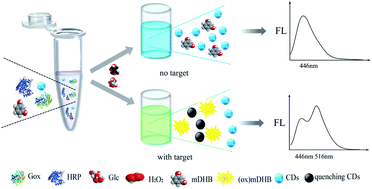Development of a novel fluorescence ratiometric glucose sensor based on carbon dots and a potential fluorophore m-dihydroxybenzene†
Abstract
m-Dihydroxybenzene (mDHB) was used as a potential fluorophore for the first time to develop a new fluorescence ratiometric sensor with carbon dots (CDs) for glucose detection. mDHB itself cannot fluoresce, but its oxide can produce fluorescence and also quench the fluorescence of CDs. Using this characteristic of mDHB, we introduced two tandem enzyme catalytic oxidation reactions (catalysed by glucose oxidase and horseradish peroxidase) to quantitatively form mDHB oxide. Glucose was oxidized by oxygen to form hydrogen peroxide under the catalysis of glucose oxidase, and then hydrogen peroxide was used to quantitatively oxidize mDHB by the catalysis of horseradish peroxidase, so mDHB oxide was quantitatively related to glucose. Furthermore, the resulting mDHB oxide can cause changes in the fluorescence ratios of CDs and mDHB oxides. Therefore, glucose can be detected by the fluorescence ratio. The results showed that glucose content had a good linear relationship with the fluorescence ratio of mDHB oxide and CDs, and the detection limit can reach 0.35 μM. The strategy was simple and cost-effective as no chemical synthesis, modification and separation procedures were involved, which can open up a new avenue for glucose detection.



 Please wait while we load your content...
Please wait while we load your content...